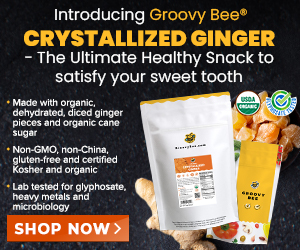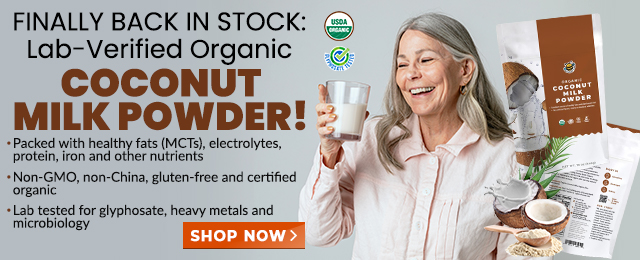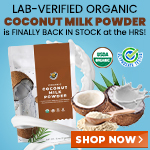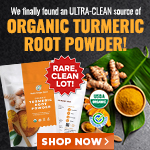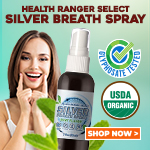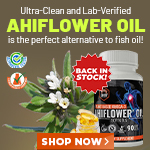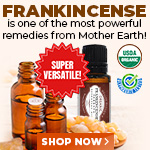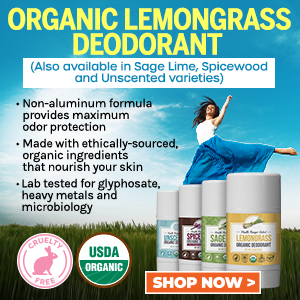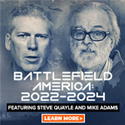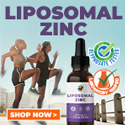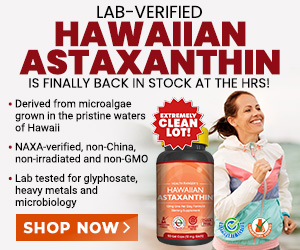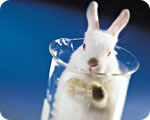
Nutrasweet - A Look at the History of Deception Behind Its Marketing (Part 2)
Tuesday, May 06, 2008 by: Jo Hartley
Tags: Nutrasweet, health news, Natural News
- The hidden war above: Chemtrails, HAARP and the battle for planetary control
- CLOT SHOT PLANDEMIC UNFOLDING: Fibrous, rubbery clots caused by covid injections have prion-like seeding activity
- Widespread social and economic unrest: Steve Quayle issues urgent financial warning of imminent asset collapse in new interview with Mike Adams
- DEATH by VACCINE or face PRISON time: Canadian Freedom Convoy leaders CONVICTED for protesting forced vaccination during the Covid Plandemic
- Hidden toll: Federal secrecy shields wind industry's eagle deaths to protect land-hungry turbines that yield minimal power
- 7 Must-have multi-functional survival tools for every prepper
- Idaho Gov. Brad Little vetoes Medical Freedom Act
- How to detox from metals falling out of the sky
- Global pedophile ring “Kidflix” shut down in landmark Europol operation
- Mark Zuckerberg's Meta allegedly trained AI on millions of stolen books from “shadow libraries”
- Top German general admits that CONSCRIPTION is “absolutely” necessary to combat Russia
- U.S. Military EXITS fake “Climate Change” hoax after a DECADE of wasting time, money, manpower and resources
- Rep. Jamie Raskin demands that 17 deported Tren de Aragua and MS-13 gang members be returned to the U.S. from El Salvador
- Trump administration SUSPENDS federal grants to Princeton University amid antisemitism probe
- Elon Musk exposes widespread Social Security fraud: “Someone is going to be arrested”
- “Rockefeller Medicine Men”: Today’s healthcare crisis stems from the creation of the American medical establishment
- New York vaccine mandate lawsuits gain momentum as Bhattacharya and Makary confirmed to lead NIH and FDA
- Aerosolized bioweapons? Strange “diploid biomasses” falling out of the sky in Florida captured under the microscope
- Newly released JFK files reveal Pentagon's role in creating Lyme disease and covid in the same lab
- European Court of Justice: Healthcare professionals who promoted or administered COVID-19 vaccines are CRIMINALLY LIABLE for any harm caused
- Aerosolized bioweapons? Strange “diploid biomasses” falling out of the sky in Florida captured under the microscope
- Oncologist warns of ‘terrifyingly aggressive’ cancers in children, linked to immune suppression from COVID vaccines
- Britain’s descent into police state censorship: Parents raided for questioning their daughter’s school system online
- Analysis: The coming economic collapse, a mass uprising and Trump's three secret weapons to halt the growing revolt
- Utah governor allows ban on LGBT pride flags in public buildings and schools, will take effect without his signature
- Kiss Your Genetic Privacy Good-Bye! 23andMe Gets Green Light to Sell Your Intimate Genetic Details to Anyone They Want
- FBI imposed gag order on agents to silence Hunter Biden laptop truth before 2020 election, new chat logs reveal
- The Health Ranger releases “Vaccine Zombie” song and music video, using AI-animated zombies for the music video
- DARPA: The shadowy innovator behind the world’s most advanced military technologies
- Mike Adams releases country western hit single: Goin’ Back in Time is Comin’ Home
- “Project Aldrin”: Senate probes Meta's alleged censorship dealings with China
- When antibiotics are unavailable, natural ANTIMICROBIAL compounds become essential first line defenses against infection
- AI-powered forecasting model proves more accurate than traditional systems at predicting the weather
- German researchers find link between mRNA vaccines and GENETIC CHANGES that precede CANCER and AUTOIMMUNE DISORDERS
- Dr. Mary Talley Bowden drops bombshells about children being permanently damaged by mRNA jabs during Tucker Carlson interview
- Ancient kitchen secrets REVEALED: How garlic, ginger and green onions fight cancer and heart disease
- Newly released JFK files reveal Pentagon's role in creating Lyme disease and covid in the same lab
- California's social media censorship law struck down: A victory for free speech or a threat to online safety?
- The Health Ranger releases “Vaccine Zombie” song and music video, using AI-animated zombies for the music video
- Dr. Mike Yeadon releases 15-minute testimony - WATCH - about genocidal intent of COVID “vaccines”
- EPA advisor admits the agency is funneling billions to climate groups ahead of Trump’s return to White House
- Rep. Nancy Mace introduces bill to ban biological males from female facilities on federal property
- Florida takes a stand: DeSantis proposes permanent ban on mRNA vaccine mandates
- Sugarcane extract superior to cholesterol-lowering drugs?
- Survival 101: Effective EMF blocking techniques
- Mike Adams releases country western hit single: Goin’ Back in Time is Comin’ Home
- OpenAI whistleblower who dissented against how the company trained ChatGPT found dead
- Attorney and TikTok influencer explains how he was offered hundreds of dollars to make false claims about Trump, Republicans
- CONSERVATIVES SOUND THE ALARM: Big Pharma and the Left trying to force $32 billion money grab from America’s seniors into year-end spending deal
- Pilots report mysterious lights 'moving at extreme speeds' across Oregon skies
- Trump expected to choose Kelly Loeffler as his agriculture secretary even though she was caught INSIDER TRADING during COVID
- Marketing director responsible for WOKE Jaguar rebrand is also an LGBT activist who supports Black Lives Matter
- Unpacking the Lies That We’ve Been Fed – new song and music video released by Mike Adams, the Health Ranger
- Poll: Majority of Ukrainians want peace negotiations to end war with Russia
- Red Cross issues warning to stop blood plasma donations from vaccinated people
- Scientists confirm: GENIUS brain function can be spontaneously unleashed in humans without any apparent cause
- EPA advisor admits the agency is funneling billions to climate groups ahead of Trump’s return to White House
- HYSSOP: What research reveals about the health benefits of this ancient holy herb
- Two containers with completed ballots fall out of truck in Florida
- Fully vaccinated about to see “tsunami” of illness and death, warns virologist
- Global leaders unite to clamp down on “misinformation” with UN-backed Cascais Declaration
- BREAKING: 2025 NDAA authorizes mandatory military draft of WOMEN across America… as Pentagon pursues global NUCLEAR war with both Russia and China at the same time
- Newly released JFK files reveal Pentagon's role in creating Lyme disease and covid in the same lab
- Michael Yon warns of a ZIONIST TAKEOVER in Trump’s second administration
- BOMBSHELL: DNA testing kits are a SCAM to develop ethnic-specific bioweapons
- Ozempic and Wegovy weight loss drugs are injectable LIZARD VENOM PEPTIDES that may unleash a devastating wave of organ failure… side effects align with symptoms of SNAKE BITES
- The Health Ranger releases “Vaccine Zombie” song and music video, using AI-animated zombies for the music video
- Israeli soldiers accused of even more torture and abuse in the West Bank
- These 13 countries just signed an agreement to engineer a global FAMINE by destroying food supply
- NASA admits that climate change occurs because of changes in Earth’s solar orbit, and NOT because of SUVs and fossil fuels
- RFK Jr. clears key hurdle: Sen. Susan Collins backs controversial HHS nominee, signaling a new era for health policy
- Sermon 30: How Jesus reveals Caesar’s FAKE CURRENCY and FALSE AUTHORITY
G.D. Searle approached Dr. Harry Waisman (Biochemist, Professor of Pediatrics, Director of the University of Wisconsin's Joseph P. Kennedy Jr. Memorial Laboratory of Mental Retardation Research, and a well-known expert in phenylalanine toxicity) in 1970 to research the effects of aspartame on primates. The study began on January 15, 1970 and ended in late April, 1971. Dr. Waisman died unexpectedly in March, of 1971.
In the study conducted by Dr. Waisman, seven infant monkeys were given aspartame with milk. One died after 300 days. Five others experienced grand mal seizures.
These actual research results were not included in the initial application that G.D. Searle submitted to the FDA. G.D. Searle denied knowledge of or involvement with anything involving this research study. However, falsified results were submitted to the FDA bearing a Searle Pathology-Toxicology project number. Dr. Waisman and G.D. Searle both were responsible for the study design. Several false statements were made by G.D. Searle, including that the animals participating in the study were unavailable for autopsy after the termination of the study.
Neuroscientist John W. Olney discovered that oral intake of glutamate, aspartame and cysteine (all excitotoxic amino acids) cause brain damage in mice. An internal G.D. Searle memorandum discussed the strategy for getting aspartame approved.
In 1971, Ann Reynolds, a researcher who was employed by G.D. Searle, confirmed aspartame's neurotoxicity in infant mice. Searle ignored her discovery.
On July 26, 1974, the FDA approved aspartame for limited use. The limited uses included free-flowing sugar substitute, tablets for sweetening hot beverages, cereals, gum, and dry bases.
In August 1974 (before aspartame could go on the market) Dr. John Olney, James Turner, and Label, Inc. (Legal Action for Buyers' Education and Labeling) filed a formal objection stating that they believed aspartame could cause brain damage, particularly in children.
On August 4, 1976, G.D. Searle representatives met with the FDA and was successful in convincing them to allow G.D. Searle to hire a private agency (University Associated for Education in Pathology (UAREP) and pay them $500,000 to "validate" 12 other studies that Searle had submitted to get aspartame approved by the FDA.
According to Arthur Hull Hayes, the FDA Commissioner during the early 1980s, the UAREP investigation was to "make sure that the studies were actually conducted."
Dr. Kenneth Endicott, Director of UAREP, stated that the FDA had "reasons to suspect" that Searle's tests "were not entirely honest." Because the FDA doubted Searle's honesty, officials wanted UAREP "to determine whether the reports were accurate."
In 1977, Donald Rumsfeld (a former member of the U.S. Congress and the Chief of Staff in the Gerald Ford Administration) was hired as President and CEO of G.D. Searle. Attorney James Turner, Esq. has alleged that G.D. Searle hired Rumsfeld to facilitate the aspartame approval difficulties that they were experiencing.
Rumsfeld's first action was to hire John Robson as Executive Vice President. Robson was a former lawyer with Sidley and Austin (Searle's Law Firm) and had also served as chairman of the Civil Aeronautics Board (then connected with the Department of Transportation). Rumsfeld also brought on Robert Shapiro as General Counsel. Shapiro had been Robson's Special Assistant at the Department of Transportation. Rumsfeld's next task was to hire William Greener, Jr., as Chief Spokesman. Greener was a former spokesman in the Gerald Ford White House.
At the time that Rumsfeld became President and CEO he was on the Board of Directors of the Chicago Tribune. Shortly after Rumsfeld became CEO of Searle he wrote an effusively positive article about the NutraSweet Company.
On January 10, 1977, it was recommended to the U.S. Attorney that a grand jury be set up to investigate G.D. Searle for violations of the Federal Food, Drug, and Cosmetic Act, U.S.C. 331(e), and the False Reports to the Government Act, 18 U.S.C. 1001. G.D. Searle and Company and three of its responsible officers were investigated for willful and knowing failure to make reports to the Food and Drug Administration and for hiding pertinent facts and making false statements in reports of the animal studies that were conducted to establish the safety of the drug Aldactone and the food additive Aspartame.
There were two studies where the violations committed by G.D. Searle appeared to be especially grievous. The two studies investigated were the previously mentioned 52-week toxicity study on infant monkeys performed by Dr. Waisman (G.D. Searle withheld important information from the FDA) and a 46-week toxicity study of hamsters (G.D. Searle had taken blood from healthy animals at the 26th week and claimed that the tests had actually been performed at the 38th week). Apparently many of the animals from this study were dead by the 38th week.
On January 26, 1977, G.D. Searle's law firm, Sidley & Austin, requested a meeting with the U.S. Attorney prior to a grand jury convening. A representative of Sidley & Austin who was present at that meeting was Newton Minow (also on the Board of Directors at the Chicago Tribune at that time).
On April 13, 1977, a memo from the U.S. Justice Department urged U.S. Attorney Samuel Skinner to proceed quickly with the grand jury investigations of G.D. Searle. The memo clearly shows that the Statute of limitations on prosecution was going to expire soon (October 10, 1977 for the Waisman study and December 8, 1977 for the other study).
On July 1, 1977, U.S. Attorney Samuel Skinner left his U.S. Attorney position to work for the G.D. Searle law firm of Sidley & Austin. Thomas Sullivan became Samuel Skinner's successor. Assistant U.S. Attorney William Conlon convened a grand jury, but he allowed the Statute of Limitations to run out on the aspartame study charges.
Just over a year later, Conlon also accepted a job with G.D. Searle's law firm, Sidley & Austin.
Robert McConnell was the Director of G.D. Searle's Department of Pathology and Toxicology, the department that oversaw most of the aspartame research. Mr. McConnell was specifically named in the initial recommendation for investigation. According to McConnell's attorney, his client was given a $15,000 bonus and it was requested he take a 3-year sabbatical (he received $60,000 for each year). He was deemed a "political liability."
In August 1977, the Bressler Report involving three key aspartame studies (E5, E77/78 and E89) was released. Some of the findings from these three studies reviewed by the Bressler-led FDA Task Force included:
1. In one study, 98 of the 196 animals participating died but were not autopsied until as much as one year later. Because of this delay, most of the animal tissue could not be used. At least 20 animals had to be excluded from postmortem examinations.
2. There was a discrepancy between the original pathology sheets and the pathology sheets submitted to the FDA. There were differences shown for 30 animals.
3. One animal was actually reported alive at week 88, dead between weeks 92 and 104, and then alive again at week 108, and finally permanently dead at week 112.
4. An outbreak of an infectious disease was not included in the report to the FDA.
5. Tissue from some animals was noted to be unavailable for analysis on the pathology sheets. However, the results from an analysis of this "unavailable" tissue were submitted to the FDA.
6. There was evidence that the diet mix was not homogeneous (allowing the animals to eat around the test substance). This evidence included a picture as well as statements by a lab technician.
7. Fifteen fetuses from animals involved in one experiment were missing.
8. Some sections from the animals were too thick for examination.
9. There was no documentation about the age or source of the animals.
10. For one study, there was no protocol until it was well underway.
11. Animals were not adequately tagged to prevent mistakes.
12. Some laboratory methods were changed during the study but this was not documented.
In March of 1979, the FDA was able to conclude that G.D. Searle's aspartame studies were acceptable. They decided to convene the Public Board of Inquiry (PBOI). This had been agreed to by Dr. John Olney and Attorney James Turner over four years earlier.
In April of 1979, the FDA outlined the specific questions that were going to be addressed by the PBOI. The scope of investigation was limited to:
a. Whether the ingestion of aspartame (alone or together with glutamate) poses a risk of contributing to mental retardation, brain damage, or undesired effects on neuroendocrine regulatory systems.
b. Whether the ingestion of aspartame may induce brain neoplasms (tumors) in rats.
Based on the answers to the above queries:
a. Should aspartame be allowed for use in foods or should the approval of aspartame be withdrawn?
b. If aspartame is allowed for use in foods (if its approval is not withdrawn) what conditions for use and labeling should be required, if any?
In June of 1979, Acting FDA Commissioner Sherwin Gardner selected the 3-person Public Board of Inquiry (BOI). The selected panelists were Peter J. Lampert, M.D. (Professor and Chairman, Department of Pathology, University of California - San Diego), Vernon R. Young, Ph.D. (University of Nutritional Biochemistry, M.I.T.) and Walle Nauta, M.D., Ph.D. (Institute Professor, Department of Psychology and Brain Science, M.I.T).
Dr. John Olney objected to the Commissioner's selection of Dr. Vernon Young on grounds of both conflict of interest and lack of qualifications.
Dr. Young had written articles in collaboration with G.D. Searle scientists, though they were not aspartame related. Additionally, Dr. Olney thought that the question of aspartic acid's neurotoxicity needed to be examined by a neuropathologist and that Dr. Young was not qualified because his field was Nutrition and Metabolism. Dr. Olney's objections were overruled by the Acting FDA Commissioner. In the end, Dr. Young was assigned to study the issue of aspartic acid toxicity.
One of the PBOI panelists, Dr. Walle Nauta, said, "It was a shocking story we were told [about Searle's animal testing] but, there was no way we could go after it. We had absolutely no way of knowing who was right. We had to take the FDA's word."
On January 21, 1981, the day after Ronald Reagan became the 40th President of the United States, G.D. Searle reapplied for the approval of aspartame. G.D. Searle submitted new studies along with their application. Reagan was expected to replace Jere Goyan, the FDA Commissioner. G.D. Searle President & CEO, Donald Rumsfeld's connections to the Republican Party were also thought to be connected to Searle's decision to reapply for aspartame's approval at that time.
According to a former G.D. Searle salesperson, Donald Rumsfeld told his sales force that, if necessary, "he would call in all his markers and that no matter what, he would see to it that aspartame would be approved that year."
Meanwhile, there were FDA scientists who were very concerned about specific problems linking aspartame with brain tumors, brain lesions, and general brain chemistry. Another concerned neuroscientist, Dr. John Olney studied aspartame extensively and he expressed his concern about the serious negative health effects aspartame consumption had on the human body.
The concerns of these top scientists were of no consequence to Rumsfeld. Rumsfeld made the decision to solve this problem politically – not scientifically.
On October 15, 1982, G.D. Searle petitioned the FDA for approval of aspartame use in soft drinks and children's vitamins.
On October 1, 1982 an amendment was attached to the Orphan Drug Act. This act encourages the development of drugs for rare diseases. The amendment extended the patent on one product -- aspartame -- by 5 years, 10 months and 17 days. The amendment did not mention aspartame or G.D. Searle specifically and there was no debate or discussion on this amendment.
This amendment was proposed by Senator Howell Heflin, brought up for vote by Senator Robert Byrd, and pushed through by Representatives Henry Waxman and Orrin Hatch. G.D. Searle requested Senator Heflin sponsor the amendment. Heflin reportedly received $9,000 in campaign donations from G.D. Searle company executives shortly after this amendment was approved. Senator Byrd received a $1,000 campaign contribution from the CEO of G.D. Searle (Rumsfeld) before the amendment was proposed. Representative Waxman received a $1,500 campaign contribution from the soft drink political action committee. Senator Hatch also received $2,500 from the soft drink political action committee prior to his re-election and $1,000 each from Daniel Searle, Wesley Dixon (Daniel Searle's brother-in-law), and William Searle. Senator Hatch has blocked hearings looking into the safety of aspartame many times.
In 1985, G.D. Searle was sold to the chemical company, Monsanto. Monsanto then created the NutraSweet Company as a separate subsidiary from G.D. Searle.
In 1992, NutraSweet signed agreements with the Coca-Cola and PepsiCo stipulating that The NutraSweet Company was their preferred supplier of aspartame. The patent for aspartame expired on December 14, 1992. This opened up the market to other companies.
In light of all of this information, it is not at all surprising that most health-conscious people now believe avoiding NutraSweet is a prudent practice. At some future point, if a scientific consensus finally concludes that aspartame puts most consumers at risk, it will be much too late. The best thing is to eat safely now.
About the author
Jo HartleyWife, Mother of 8, and Grandmother of 2
Jo is a 41 year old home educator who has always gravitated toward a natural approach to life. She enjoys learning as much as possible about just about anything!
http://loftymatters.com - Current Events
http://winemaiden.com - Simply Abundant Living
Nutrasweet at FETCH.news
Get independent news alerts on natural cures, food lab tests, cannabis medicine, science, robotics, drones, privacy and more.
More news on Nutrasweet
Take Action: Support Natural News by linking to this article from your website
Permalink to this article:
Embed article link: (copy HTML code below):
Reprinting this article:
Non-commercial use OK, cite NaturalNews.com with clickable link.
Follow Natural News on Facebook, Twitter, Google Plus, and Pinterest
Science News & Studies
Medicine News and Information
Food News & Studies
Health News & Studies
Herbs News & Information
Pollution News & Studies
Cancer News & Studies
Climate News & Studies
Survival News & Information
Gear News & Information
News covering technology, stocks, hackers, and more



"Big Tech and mainstream media are constantly trying to silence the independent voices that dare to bring you the truth about toxic food ingredients, dangerous medications and the failed, fraudulent science of the profit-driven medical establishment.
Email is one of the best ways to make sure you stay informed, without the censorship of the tech giants (Google, Apple, Facebook, Twitter, YouTube, etc.). Stay informed and you'll even likely learn information that may help save your own life."
–The Health Ranger, Mike Adams










